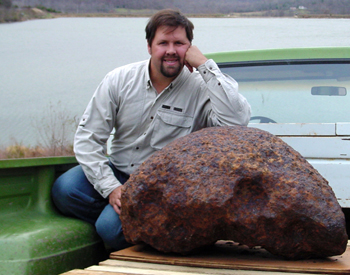 In October,
Steve Arnold was scanning a field in Kansas with his modified metal detector
when he heard a familiar tone, indicating the presence of a metallic object
belowground. The sound could have indicated just another wagon wheel or piece
of lost farm equipment, but Arnold instead pulled from a depth of 2 meters a
rare meteorite — the largest of its kind discovered anywhere in the world.
In October,
Steve Arnold was scanning a field in Kansas with his modified metal detector
when he heard a familiar tone, indicating the presence of a metallic object
belowground. The sound could have indicated just another wagon wheel or piece
of lost farm equipment, but Arnold instead pulled from a depth of 2 meters a
rare meteorite — the largest of its kind discovered anywhere in the world.Steve Arnold, meteorite hunter and broker, poses with the 650-kilogram meteorite that he found in a Kansas farm field. Image courtesy of Qynn Arnold.
The 650-kilogram (1,430-pound) rock is one of numerous debris chunks that scattered when a meteor crashed near what is now Haviland, Kan., sometime between 1,000 and 2,000 years ago. This particular piece of the “Brenham” meteorite contains an iron-nickel alloy embedded with olivine crystals that scientists classify as a “pallasite.” But it was not the composition that proved unique (most Brenham specimens are pallasites); rather it was the rock’s size combined with how it entered the atmosphere that made it a rare find.
The specific locations of such meteorites in the Brenham fall might provide new insight to the dynamics of meteorite impacts. For Arnold, such information could possibly help him find additional specimens. Based in Kingston, Ark., he works as a broker for collectors, matching up prospective buyers with specimens on the market — some of which he finds during meteorite hunting expeditions.
After browsing documentation of the specific locations of previous Brenham findings, which Arnold calls “a treasure map,” he says that he thought that more rocks remained undiscovered. But 16 square kilometers (4,000 acres) was too large an area to search, so he narrowed his focus to a smaller area that he thought records indicated had not been thoroughly searched with modern metal-detecting equipment. “If he was partly right, we could recover some meteorites and make a fair profit,” says Phil Mani, a geologist turned oil and gas attorney who financed the search and recovery efforts.
Arnold and Mani gathered equipment, drove to Kansas, started hunting and “two weeks later, we run into this big thing,” Arnold says, which was larger than either of them had hoped for. Also surprising was the meteorite’s shape. Most meteorites enter the atmosphere tumbling, which effectively rounds the rock. Instead, this rock was cone-shaped with a jagged backside, indicating it had a stable, or “oriented,” position upon entry. “When you find oriented meteorites, they tell you something different than nonoriented meteorites,” Mani says.
Impacts typically distribute meteorites over a “strewn field” shaped like an ellipse, the exact parameters of which depend on physical factors such as the object’s angle and speed as it falls, and possibly the shape of the rock. While documenting a different meteor fall in Park Forrest, Ill., Arnold and colleagues found that oriented stones fall in a pattern different from non-oriented stones. He says that in that case, oriented meteorites tended to stay closer to the axis of the ellipse, possibly because they had a more stable flight.
Arthur Ehlmann, a geologist at Texas Christian University in Fort Worth, who studies meteorites, says that it makes sense that oriented pieces should fall straight down the center, while irregular shapes would “veer off to the side.” Arnold and Mani hope to see if this pattern also holds true for the Brenham strewn field.
A legal contract with the land-owners for exclusive meteorite-hunting rights will allow Arnold and Mani to document the size, shape and location (via GPS) of each Brenham meteorite that they find. But just as important, they say, are areas that do not turn up meteorites because they help to define the strewn field perimeter. Defining the patterns and borders of the strewn field will help in “maximizing recovery of Brenham meteorites,” Mani says.
Selling the recently discovered meteorite for profit does not concern Ehlmann, who says that other than helping to define the strewn field, the large piece is unlikely to turn up any new scientific results. Most scientific information has already been gleaned from previous specimens recovered from the same impact, which scattered about 3 tons of material over Kansas farmland. Other specimens, for example, have been sufficient for scientists to arrive at the leading hypothesis that a pallasite forms when an early planet’s cooling molten core forces it to mix with olivine in its mantle.
Denton Ebel, curator of the Arthur Ross Hall of Meteorites at the American Museum of Natural History in New York City, says that purchasing the meteorite as a whole would be beyond the budget of the museum, but if the meteorite were cut into sections, he would be interested in procuring a piece. “After all,” he says, “it’s not like a dinosaur skeleton where if you take the head off, it changes it.” Arnold and Mani say that they prefer to sell the meteorite to a party that plans to keep it in one piece.

